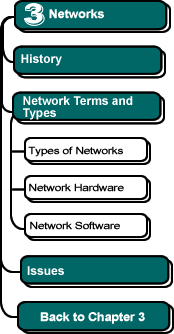

|
Lesson 2: Network Terms and Types
LANs vs.
WANs
Computer
networks are often divided into two categories:
- Local-Area
Networks (LANs), in which all of the computers comprising the
network are in close geographic proximity to each other, and

- Wide-Area Networks, (WANs), which include some long-distance connections.
An example of a local-area network would be the Limerick network at Calvin, which connects computers in the student computer labs, enabling access to shared disk drives and printers.
 An
example of a wide-area network would be the National
Weather Service, which connects weather-system computes through the
U.S. and territories. The Internet itself can also be considered a WAN.
An
example of a wide-area network would be the National
Weather Service, which connects weather-system computes through the
U.S. and territories. The Internet itself can also be considered a WAN.
One of the main factors that serves to distinguish LANs and WANs is the
category of network hardware involved. LANs use standard
network hardware, and there are limits to the distances that such technologies
can extend before transmissions are no longer functional. On the other
hand, in order to transmit over distance for WAN, technologies beyond
those of conventional network hardware are required: e.g., high-speed
data lines leased from a telecommunications company, or satellite technology.
Next we look at network hardware.
![]()
![]()
This chapter was written by Jeff Nyhoff and Joel Adams. Copy editing by
Nancy Zylstra
©2005 Calvin University (formerly Calvin College), All Rights Reserved
If you encounter technical errors, contact computing@calvin.edu.